[ad_1]
For EIP-4844, Ethereum purchasers want the power to compute and confirm KZG commitments. Somewhat than every shopper rolling their very own crypto, researchers and builders got here collectively to write down c-kzg-4844, a comparatively small C library with bindings for higher-level languages. The thought was to create a strong and environment friendly cryptographic library that each one purchasers might use. The Protocol Safety Analysis workforce on the Ethereum Basis had the chance to overview and enhance this library. This weblog submit will talk about some issues we do to make C initiatives safer.
Fuzz
Fuzzing is a dynamic code testing method that includes offering random inputs to find bugs in a program. LibFuzzer and afl++ are two common fuzzing frameworks for C initiatives. They’re each in-process, coverage-guided, evolutionary fuzzing engines. For c-kzg-4844, we used LibFuzzer since we have been already well-integrated with LLVM undertaking’s different choices.
Here is the fuzzer for verify_kzg_proof, one among c-kzg-4844’s capabilities:
#embody "../base_fuzz.h" static const size_t COMMITMENT_OFFSET = 0; static const size_t Z_OFFSET = COMMITMENT_OFFSET + BYTES_PER_COMMITMENT; static const size_t Y_OFFSET = Z_OFFSET + BYTES_PER_FIELD_ELEMENT; static const size_t PROOF_OFFSET = Y_OFFSET + BYTES_PER_FIELD_ELEMENT; static const size_t INPUT_SIZE = PROOF_OFFSET + BYTES_PER_PROOF; int LLVMFuzzerTestOneInput(const uint8_t* information, size_t measurement) { initialize(); if (measurement == INPUT_SIZE) { bool okay; verify_kzg_proof( &okay, (const Bytes48 *)(information + COMMITMENT_OFFSET), (const Bytes32 *)(information + Z_OFFSET), (const Bytes32 *)(information + Y_OFFSET), (const Bytes48 *)(information + PROOF_OFFSET), &s ); } return 0; }
When executed, that is what the output appears to be like like. If there have been an issue, it might write the enter to disk and cease executing. Ideally, it’s best to be capable of reproduce the issue.
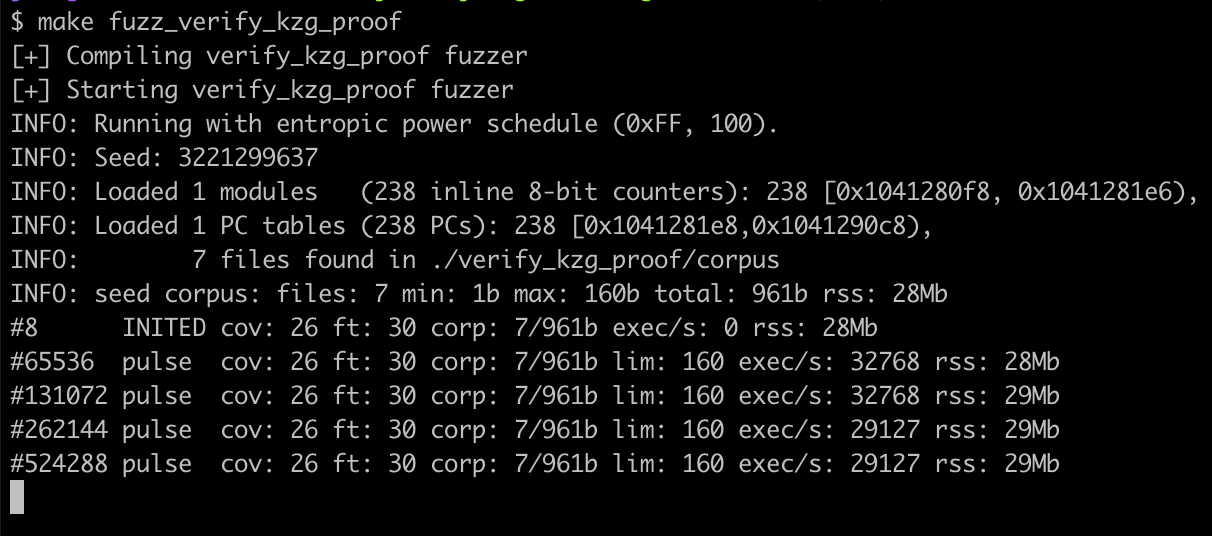
There’s additionally differential fuzzing, which is a way which fuzzes two or extra implementations of the identical interface and compares the outputs. For a given enter, if the output is totally different, and also you anticipated them to be the identical, you realize one thing is improper. This method may be very common in Ethereum as a result of we prefer to have a number of implementations of the identical factor. This diversification gives an additional stage of security, figuring out that if one implementation have been flawed the others could not have the identical challenge.
For KZG libraries, we developed kzg-fuzz which differentially fuzzes c-kzg-4844 (via its Golang bindings) and go-kzg-4844. To date, there have not been any variations.
Protection
Subsequent, we used llvm-profdata and llvm-cov to generate a protection report from working the exams. This can be a nice approach to confirm code is executed (“lined”) and examined. See the coverage goal in c-kzg-4844’s Makefile for an instance of how one can generate this report.
When this goal is run (i.e., make protection) it produces a desk that serves as a high-level overview of how a lot of every operate is executed. The exported capabilities are on the high and the non-exported (static) capabilities are on the underside.

There may be loads of inexperienced within the desk above, however there may be some yellow and pink too. To find out what’s and is not being executed, confer with the HTML file (protection.html) that was generated. This webpage exhibits the complete supply file and highlights non-executed code in pink. On this undertaking’s case, many of the non-executed code offers with hard-to-test error instances comparable to reminiscence allocation failures. For instance, this is some non-executed code:

Initially of this operate, it checks that the trusted setup is large enough to carry out a pairing test. There is not a check case which gives an invalid trusted setup, so this does not get executed. Additionally, as a result of we solely check with the proper trusted setup, the results of is_monomial_form is all the time the identical and would not return the error worth.
Profile
We do not suggest this for all initiatives, however since c-kzg-4844 is a efficiency essential library we predict it is vital to profile its exported capabilities and measure how lengthy they take to execute. This may also help establish inefficiencies which might probably DoS nodes. For this, we used gperftools (Google Efficiency Instruments) as an alternative of llvm-xray as a result of we discovered it to be extra feature-rich and simpler to make use of.
The next is an easy instance which profiles my_function. Profiling works by checking which instruction is being executed once in a while. If a operate is quick sufficient, it might not be seen by the profiler. To cut back the possibility of this, chances are you’ll must name your operate a number of occasions. On this instance, we name my_function 1000 occasions.
#embody <gperftools/profiler.h> int task_a(int n) { if (n <= 1) return 1; return task_a(n - 1) * n; } int task_b(int n) { if (n <= 1) return 1; return task_b(n - 2) + n; } void my_function(void) { for (int i = 0; i < 500; i++) { if (i % 2 == 0) { task_a(i); } else { task_b(i); } } } int major(void) { ProfilerStart("instance.prof"); for (int i = 0; i < 1000; i++) { my_function(); } ProfilerStop(); return 0; }
Use ProfilerStart(“<filename>”) and ProfilerStop() to mark which components of your program to profile. When re-compiled and executed, it would write a file to disk with profiling information. You possibly can then use pprof to visualise this information.

Right here is the graph generated from the command above:

Here is a much bigger instance from one among c-kzg-4844’s capabilities. The next picture is the profiling graph for compute_blob_kzg_proof. As you may see, 80% of this operate’s time is spent performing Montgomery multiplications. That is anticipated.
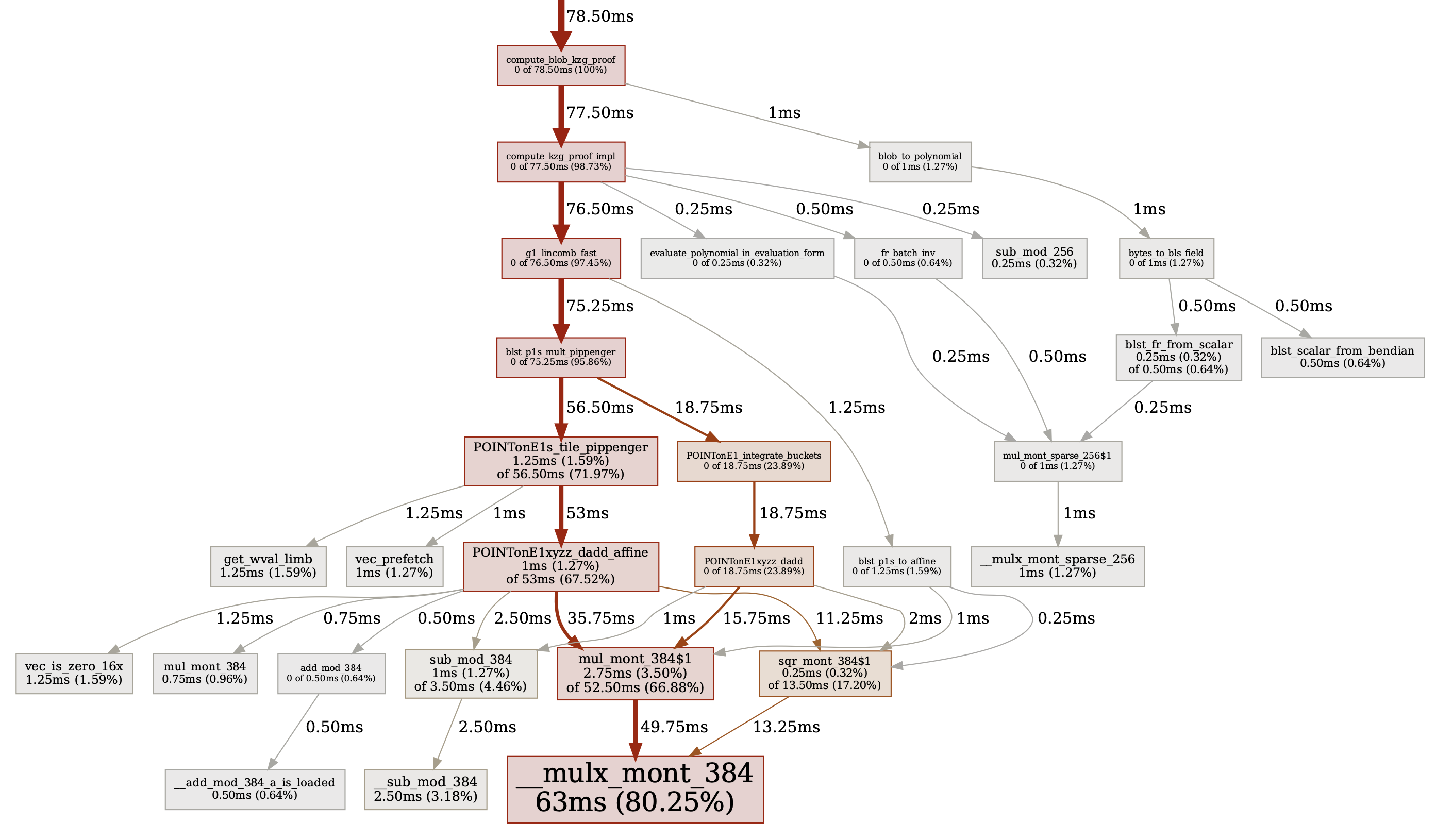
Reverse
Subsequent, view your binary in a software program reverse engineering (SRE) instrument comparable to Ghidra or IDA. These instruments may also help you perceive how high-level constructs are translated into low-level machine code. We expect it helps to overview your code this fashion; like how studying a paper in a distinct font will pressure your mind to interpret sentences in another way. It is also helpful to see what sort of optimizations your compiler makes. It is uncommon, however typically the compiler will optimize out one thing which it deemed pointless. Preserve an eye fixed out for this, one thing like this truly occurred in c-kzg-4844, some of the tests were being optimized out.
While you view a decompiled operate, it won’t have variable names, advanced varieties, or feedback. When compiled, this data is not included within the binary. It is going to be as much as you to reverse engineer this. You may usually see capabilities are inlined right into a single operate, a number of variables declared in code are optimized right into a single buffer, and the order of checks are totally different. These are simply compiler optimizations and are typically wonderful. It could assist to construct your binary with DWARF debugging data; most SREs can analyze this part to supply higher outcomes.
For instance, that is what blob_to_kzg_commitment initially appears to be like like in Ghidra:
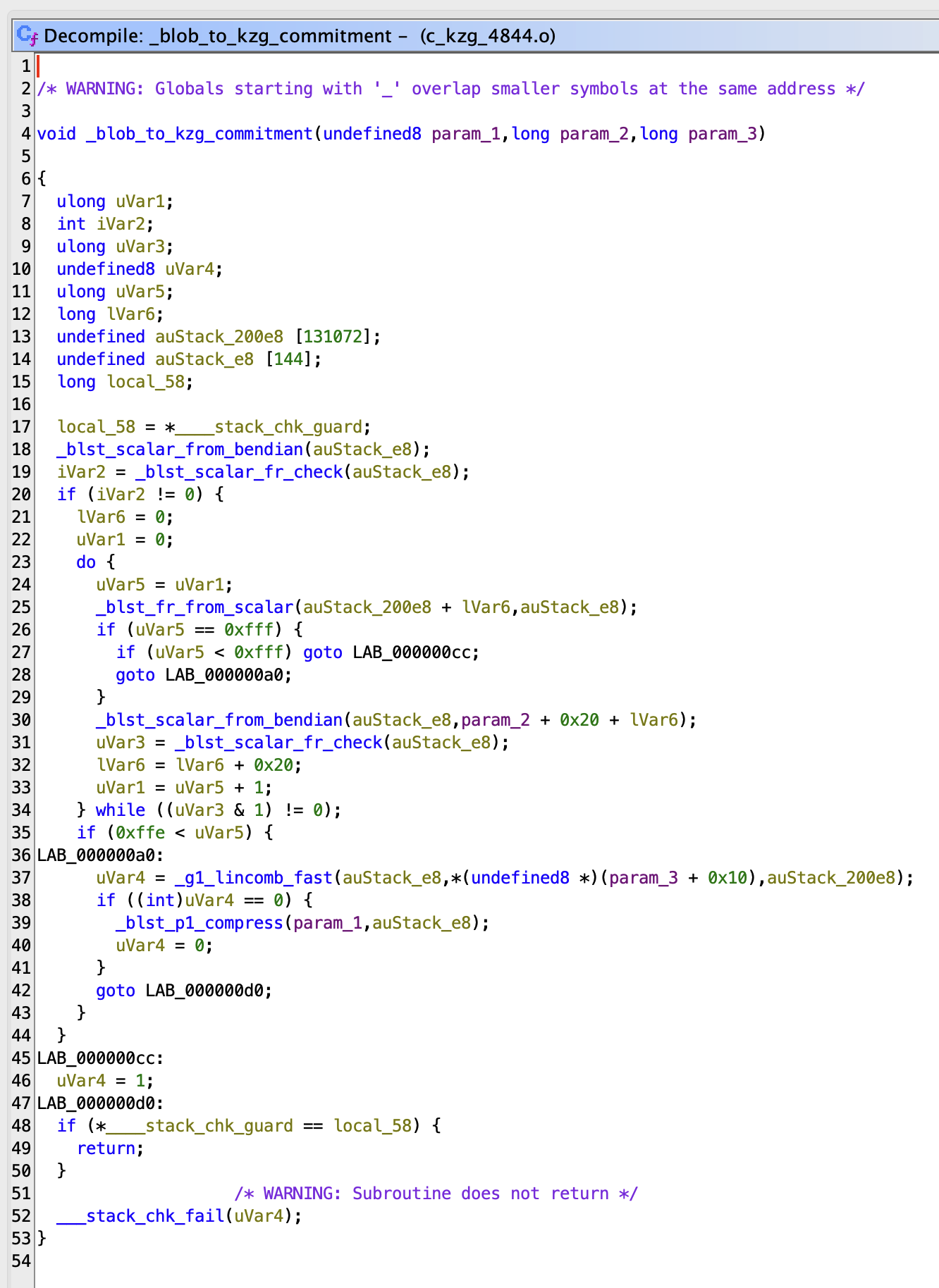
With just a little work, you may rename variables and add feedback to make it simpler to learn. Here is what it might seem like after a couple of minutes:
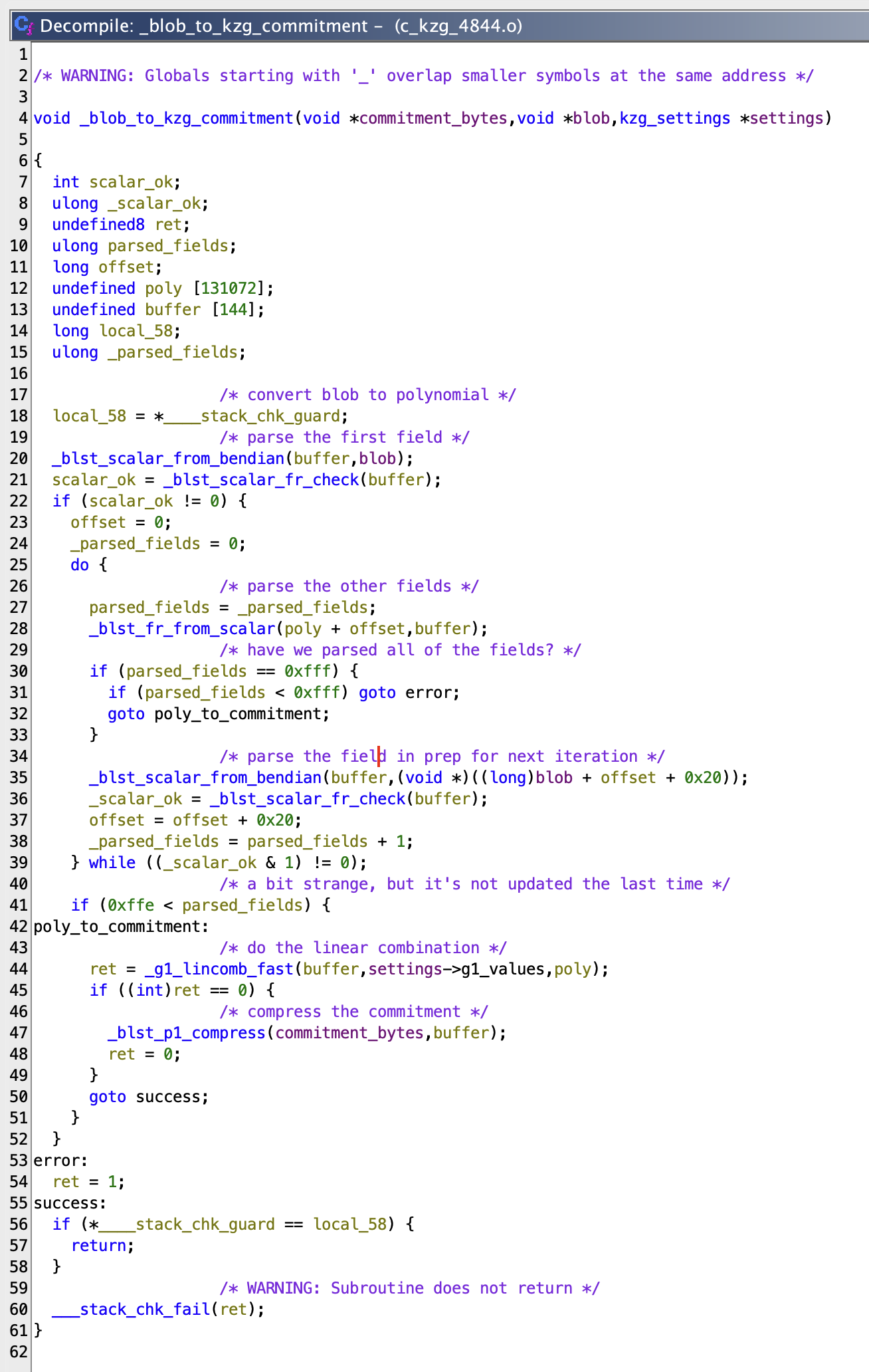
Static Evaluation
Clang comes built-in with the Clang Static Analyzer, which is a wonderful static evaluation instrument that may establish many issues that the compiler will miss. Because the identify “static” suggests, it examines code with out executing it. That is slower than the compiler, however lots quicker than “dynamic” evaluation instruments which execute code.
Here is a easy instance which forgets to free arr (and has one other downside however we are going to discuss extra about that later). The compiler won’t establish this, even with all warnings enabled as a result of technically that is fully legitimate code.
#embody <stdlib.h> int major(void) { int* arr = malloc(5 * sizeof(int)); arr[5] = 42; return 0; }
The unix.Malloc checker will establish that arr wasn’t freed. The road within the warning message is a bit deceptive, nevertheless it is smart if you consider it; the analyzer reached the return assertion and seen that the reminiscence hadn’t been freed.

Not all the findings are that straightforward although. Here is a discovering that Clang Static Analyzer present in c-kzg-4844 when initially launched to the undertaking:

Given an sudden enter, it was doable to shift this worth by 32 bits which is undefined conduct. The answer was to limit the enter with CHECK(log2_pow2(n) != 0) in order that this was not possible. Good job, Clang Static Analyzer!
Sanitize
Santizers are dynamic evaluation instruments which instrument (add directions) to applications which may level out points throughout execution. These are significantly helpful at discovering frequent errors related to reminiscence dealing with. Clang comes built-in with a number of sanitizers; listed below are the 4 we discover most helpful and straightforward to make use of.
Handle
AddressSanitizer (ASan) is a quick reminiscence error detector which may establish out-of-bounds accesses, use-after-free, use-after-return, use-after-scope, double-free, and reminiscence leaks.
Right here is identical instance from earlier. It forgets to free arr and it’ll set the sixth aspect in a 5 aspect array. This can be a easy instance of a heap-buffer-overflow:
#embody <stdlib.h> int major(void) { int* arr = malloc(5 * sizeof(int)); arr[5] = 42; return 0; }
When compiled with -fsanitize=deal with and executed, it would output the next error message. This factors you in an excellent route (a 4-byte write in major). This binary may very well be considered in a disassembler to determine precisely which instruction (at major+0x84) is inflicting the issue.

Equally, this is an instance the place it finds a heap-use-after-free:
#embody <stdlib.h> int major(void) { int *arr = malloc(5 * sizeof(int)); free(arr); return arr[2]; }

It tells you that there is a 4-byte learn of freed reminiscence at major+0x8c.
Reminiscence
MemorySanitizer (MSan) is a detector of uninitialized reads. Here is a easy instance which reads (and returns) an uninitialized worth:
int major(void) { int information[2]; return information[0]; }
When compiled with -fsanitize=reminiscence and executed, it would output the next error message:

Undefined Conduct
UndefinedBehaviorSanitizer (UBSan) detects undefined conduct, which refers back to the state of affairs the place a program’s conduct is unpredictable and never specified by the langauge commonplace. Some frequent examples of this are accessing out-of-bounds reminiscence, dereferencing an invalid pointer, studying uninitialized variables, and overflow of a signed integer. For instance, right here we increment INT_MAX which is undefined conduct.
#embody <limits.h> int major(void) { int a = INT_MAX; return a + 1; }
When compiled with -fsanitize=undefined and executed, it would output the next error message which tells us precisely the place the issue is and what the circumstances are:

Thread
ThreadSanitizer (TSan) detects information races, which may happen in multi-threaded applications when two or extra threads entry a shared reminiscence location on the similar time. This example introduces unpredictability and might result in undefined conduct. Here is an instance by which two threads increment a worldwide counter variable. There are not any locks or semaphores, so it is totally doable that these two threads will increment the variable on the similar time.
#embody <pthread.h> int counter = 0; void *increment(void *arg) { (void)arg; for (int i = 0; i < 1000000; i++) counter++; return NULL; } int major(void) { pthread_t thread1, thread2; pthread_create(&thread1, NULL, increment, NULL); pthread_create(&thread2, NULL, increment, NULL); pthread_join(thread1, NULL); pthread_join(thread2, NULL); return 0; }
When compiled with -fsanitize=thread and executed, it would output the next error message:
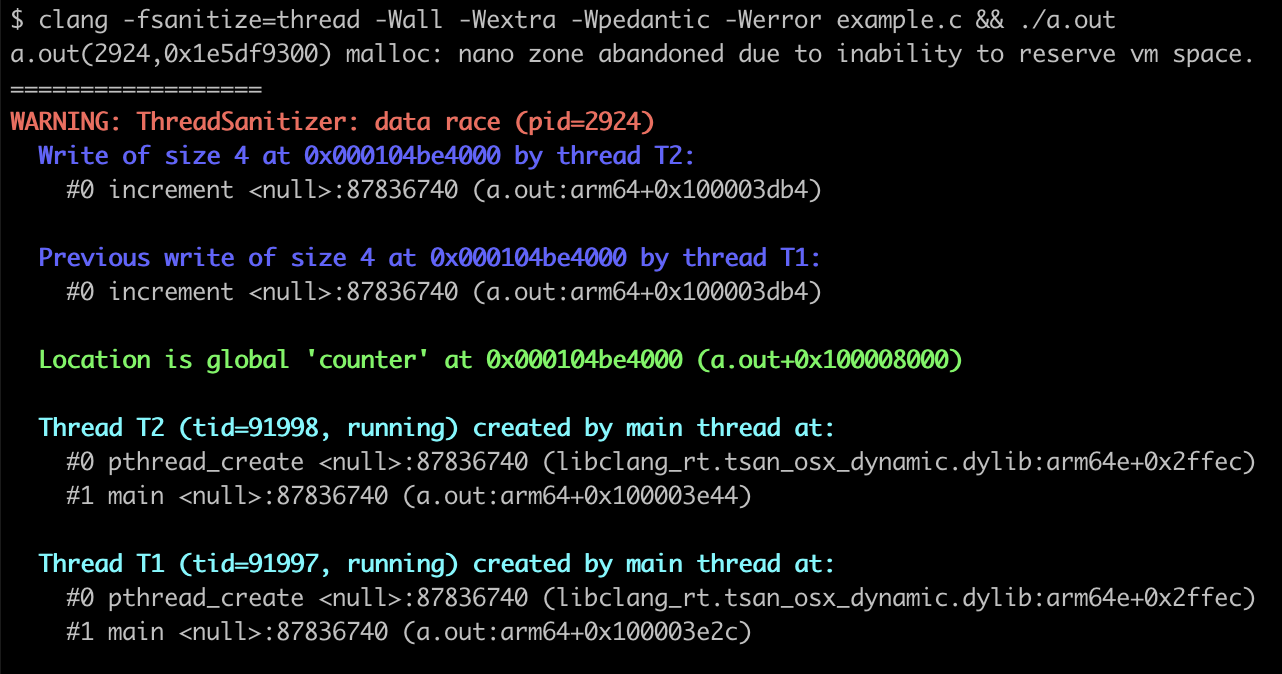
This error message tells us that there is a information race. In two threads, the increment operate is writing to the identical 4 bytes on the similar time. It even tells us that the reminiscence is counter.
Valgrind
Valgrind is a strong instrumentation framework for constructing dynamic evaluation instruments, however its greatest recognized for figuring out reminiscence errors and leaks with its built-in Memcheck instrument.
The next picture exhibits the output from working c-kzg-4844’s exams with Valgrind. Within the pink field is a legitimate discovering for a “conditional soar or transfer [that] will depend on uninitialized worth(s).”
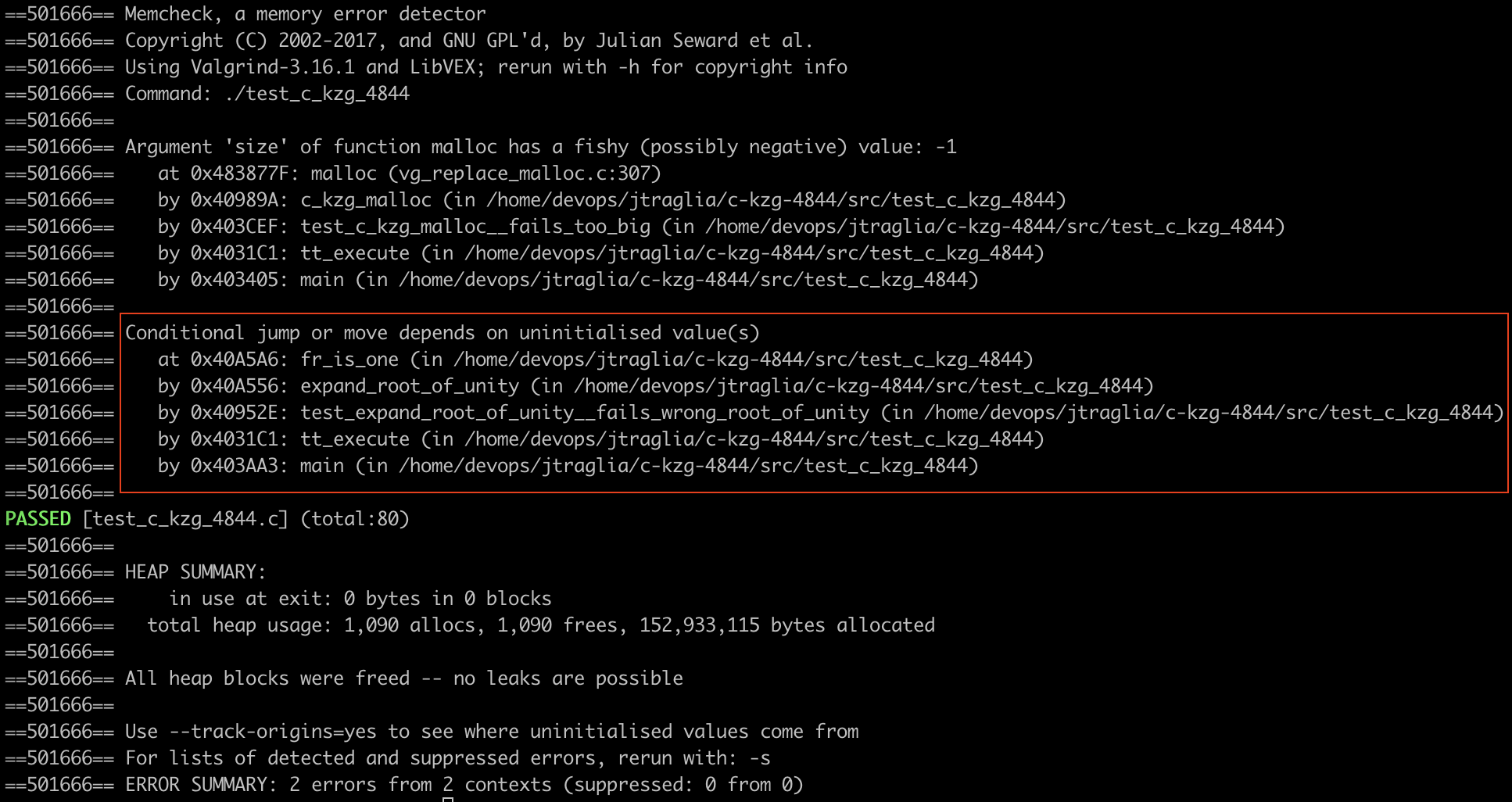
This identified an edge case in expand_root_of_unity. If the improper root of unity or width have been offered, it was doable that the loop will break earlier than out[width] was initialized. On this state of affairs, the ultimate test would rely upon an uninitialized worth.
static C_KZG_RET expand_root_of_unity( fr_t *out, const fr_t *root, uint64_t width ) { out[0] = FR_ONE; out[1] = *root; for (uint64_t i = 2; !fr_is_one(&out[i - 1]); i++) { CHECK(i <= width); blst_fr_mul(&out[i], &out[i - 1], root); } CHECK(fr_is_one(&out[width])); return C_KZG_OK; }
Safety Overview
After improvement stabilizes, it has been completely examined, and your workforce has manually reviewed the codebase themselves a number of occasions, it is time to get a safety overview by a good safety group. This may not be a stamp of approval, nevertheless it exhibits that your undertaking is not less than considerably safe. Have in mind there isn’t any such factor as excellent safety. There’ll all the time be the danger of vulnerabilities.
For c-kzg-4844 and go-kzg-4844, the Ethereum Basis contracted Sigma Prime to conduct a safety overview. They produced this report with 8 findings. It comprises one essential vulnerability in go-kzg-4844 that was a extremely good discover. The BLS12-381 library that go-kzg-4844 makes use of, gnark-crypto, had a bug which allowed invalid G1 and G2 factors to be sucessfully decoded. Had this not been mounted, this might have resulted in a consensus bug (a disagreement between implementations) in Ethereum.
Bug Bounty
If a vulnerability in your undertaking may very well be exploited for features, like it’s for Ethereum, take into account organising a bug bounty program. This permits safety researchers, or anybody actually, to submit vulnerability experiences in trade for cash. Usually, that is particularly for findings which may show that an exploit is feasible. If the bug bounty payouts are affordable, bug finders will notify you of the bug moderately than exploiting it or promoting it to a different get together. We suggest beginning your bug bounty program after the findings from the primary safety overview are resolved; ideally, the safety overview would value lower than the bug bounty payouts.
Conclusion
The event of strong C initiatives, particularly within the essential area of blockchain and cryptocurrencies, requires a multi-faceted strategy. Given the inherent vulnerabilities related to the C language, a mix of greatest practices and instruments is crucial for producing resilient software program. We hope our experiences and findings from our work with c-kzg-4844 present invaluable insights and greatest practices for others embarking on related initiatives.
[ad_2]
Source link


